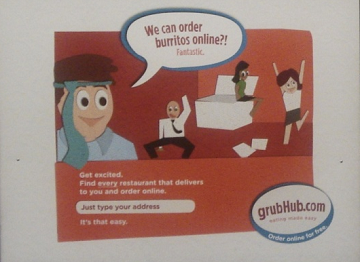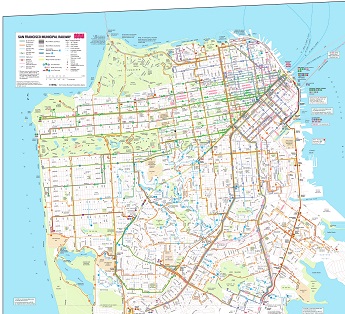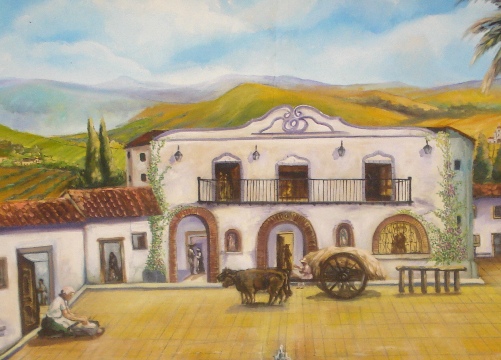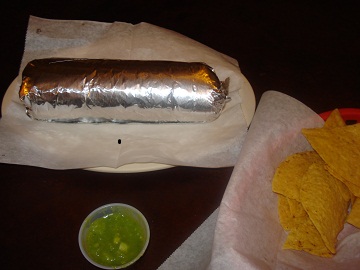
The news of burritos available online sends office workers into a frenzy in this ad from Grubhub.com. Photo by author.
One hundred feet below the Starbucks and suits of San Francisco’s financial district, Grubhub.com’s posters beckon from the BART station walls. The online food delivery service offers every kind of cuisine, from hamburgers to filet mignon. But its ads, placed in the city’s train stations and on its buses, broadcast the availability of only three foods: burritos, pizza, and sushi—all handheld, portable, and associated with a distinct ethnic group.
What do we seek when we pursue dining experiences that serve ethnicity alongside entrées? Feminist scholar bell hooks writes that, “within commodity culture, ethnicity becomes spice, seasoning that can liven up the dull dish that is mainstream white culture” (hooks, “Eating the Other: Desire and Resistance”). When ethnic difference becomes a commodity, hooks argues, it can be purchased, consumed, and deactivated. Nuanced legacies of multiethnic interaction get overlooked in favor of decontextualized food items whose consumption diners mistake for an authentic cultural exchange.

Map of San Francisco and its public transportation routes. Source: Sfmta.com.
In their merging of public transportation, ethnicity, and food, Grubhub’s ads offer an abbreviated version of an everyday San Francisco experience. The city’s thirty-plus neighborhoods are often delineated along ethnic, as well as cultural and geographic, lines. Public transportation facilitates travel among these enclaves, many of which are associated with a type of ethnic food.
For example: You take the 38 Geary to the Richmond for pho, the 22 Fillmore to the Mission for mole burritos. The 1 California takes you through Chinatown, where you can get cheap dim sum. Grubhub provides one slice of this experience—food—offering weary train and bus riders the opportunity to stay home and order with just a computerized click. But staying home misses the point: there’s a conversation going on between San Francisco’s neighborhoods and its food, and in that dialogue’s rhythms and silences are revelations about the meals on our plates and the city around us.

Diners pretend to admire a mural inside a taqueria on 24th Street in San Francisco's Mission district. Photo by the author.
I’m in a taqueria on 24th Street in the Mission. A futbol match between Argentina and Honduras plays on the television overhead. The only time I know what’s going on in the game is when the Spanish-speaking announcer pulls out the word “Goooaaal” like taffy. It’s 2011, but the restaurant’s interior is set in the early nineteenth century. Tiled eaves and arched doorways adorn the walls, while a mural depicts a pastoral scene set in a presumably Mexican rancho: women knead tortillas in a courtyard, bison stand yoked to a cart, and hilly fields of agriculture extend to the horizon. The white couple sitting in front of the mural offers to pretend to admire it while I take a picture.

Mural detail. Photo by the author.
The Mission district, home to the city’s Irish immigrants in the first half of the twentieth century, has been a predominantly Latino neighborhood since World War II. Like many neighborhoods labeled “ethnic,” the district also historically attracted artists seeking low rents and non-mainstream culture. In the late 1990s and early 2000s, mostly white tech workers, fueled by the high salaries of the dot-com boom, began moving into the Mission district. The current neighborhood reflects these waves of migration.

A taqueria and art gallery on 24th Street. Photo by the author.
- The Mission is many things at once: it is the site of a turf battle between the Sureño and Norteño gangs, home to hundreds of taquerias, numerous Catholic churches, alternative art spaces, exclusive foodie hotspots, and more fixed-gear bicycles than you can shake a stick at. Figures from the 2010 census reveal that white residents have increased from 52 to 57 percent of the neighborhood, while Latinos make up 41 percent, down from 52 percent in 1990. Local blog Mission Mission asked readers to submit a neighborhood caption. The winning entry: “Where Latinos and hipsters politely ignore each other’s existence.” It says it all.
-

Burrito, salsa, chips. Photo by the author.
It’s simpler inside the taqueria. Awkward cultural exchanges may be taking place on the sidewalks and in the nearby apartment buildings, but here, “Latino culture” is neatly wrapped and only $6, chips included. Or it’s in the mural, which locates ethnicity safely in the past, stuck in time and place.
Within the neighborhood’s dynamic and multi-ethnic landscape, such simplistic presentations offer a misleading though reassuring counterpoint. As white people live amongst and displace long-standing Latino residents, burritos and tacos offer white diners a non-confrontational cultural experience in which concern over what type of salsa to choose displaces concern over gentrification.

Sita Kuratomi Bhaumik, "To Curry Favor: Scented Work on Paper by SITA KURATOMI BHAUMIK," 2010; installation view, 18 Reasons. Photo: Blair Sneddon.
In my next installment, I interview Sita Bhaumik, a San Francisco–based artist whose curry powder–centric work engages with ideas of food, ethnicity, and difference.




